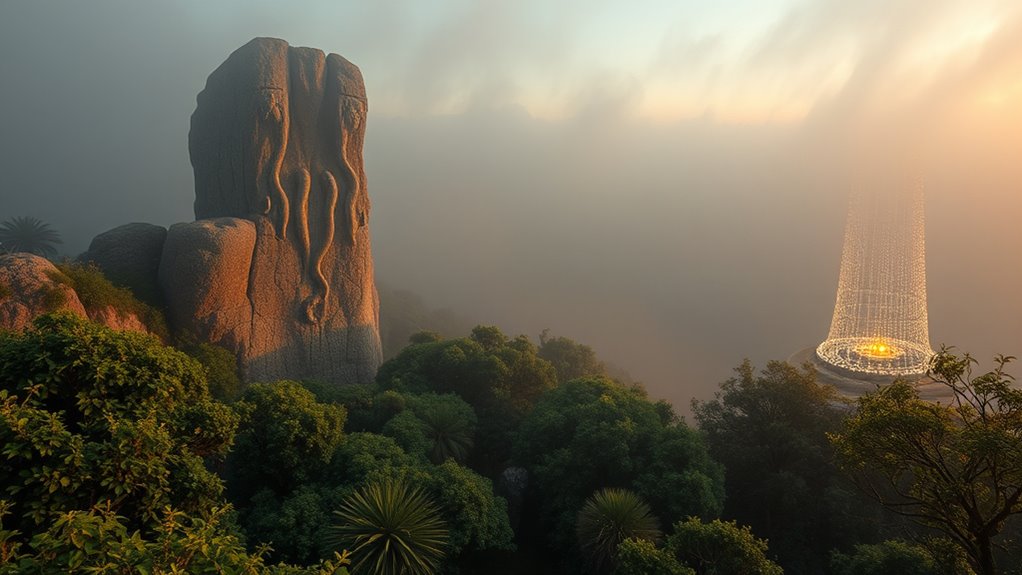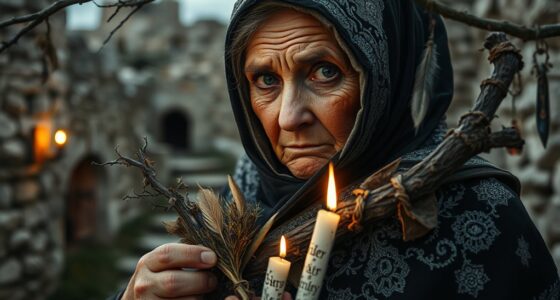Sardinia is full of mythical creatures and legendary landscapes that capture your imagination. You might hear stories of luminous Janas fairies guarding ancient tombs, or encounter fierce beasts like Su Scultone dragons protecting hidden treasures. Sea legends tell of mermaids and divine guardians patrolling the waters, while stories link the island to the lost city of Atlantis. To uncover the full richness of Sardinia’s myths, explore the fascinating tales and mysterious sites that bring these legends to life.
Key Takeaways
- Sardinia is home to legendary landscape features like Sella del Diavolo and Su Sterru Cave, linked to mythological stories.
- Janas are luminous fairy-like beings guarding treasures and embodying moral lessons in Sardinian mythology.
- Mythical guardians such as Su Scultone and Su Sirboni protect hidden treasures in caves and forests.
- Marine myths include sea guardians like Torco and celestial protectors, emphasizing Sardinia’s maritime cultural heritage.
- Sardinia’s possible connection to Atlantis and underwater ruins suggest a legendary, sunken ancient civilization.
Legendary Landscape Features of Sardinia
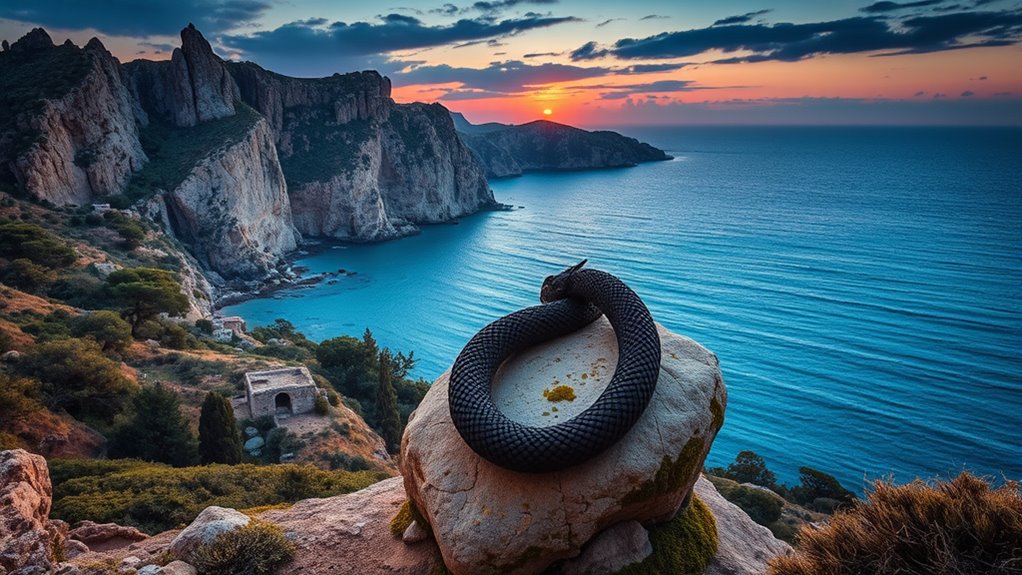
Have you ever wondered if the striking landscapes of Sardinia hold stories beyond their natural beauty? The Sella del Diavolo, a dramatic rock formation in Cagliari, is one such legend. It’s said to be Lucifer’s saddle, either petrified after his failed attempt to claim the gulf or an imprint of his body. Nearby, the Golfo degli Angeli honors angels that protected the area, symbolizing the ongoing battle between good and evil. On the Baunei plateau, Su Sterru Cave tells a different story—St. Peter trapped a basilisk there, causing the earth to open. These formations aren’t just geological wonders; they’re living stories, rooted in local folklore, connecting Sardinia’s landscape to ancient legends of divine intervention and mythical battles. Sardinia’s landscape is also dotted with mysterious nuraghi towers and ancient tombs that deepen these legends, suggesting that the island’s natural features and archaeological sites are intertwined with stories of gods, giants, and divine battles. Additionally, the geological features of Sardinia often resemble mythical creatures, further fueling local legends and cultural identity.
The Enchanting Janas: Sardinian Fairies
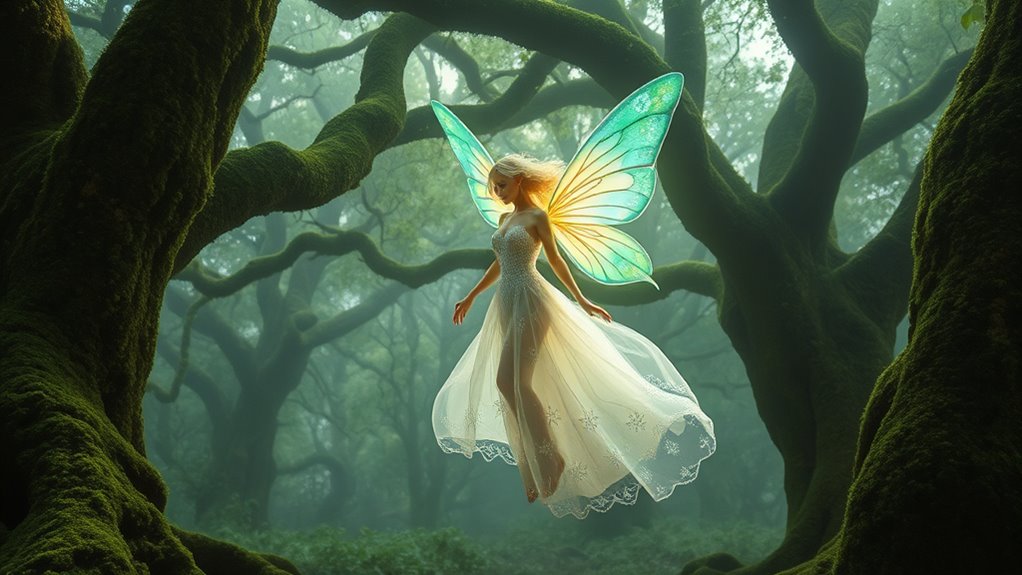
The Janas are enchanting, luminous fairy-like beings deeply woven into Sardinian mythology, embodying the island’s primal connection to nature and the divine. You’ll find them as small, radiant figures wearing striking garments, like red-purple dresses embroidered with gold and silver, glowing softly in the night. They inhabit the ancient Domus de Janas—rock-cut tombs scattered across Sardinia—crafted with delicate precision by the Janas themselves. These fairy beings act as guardians of hidden treasures, such as moonlight spun into gold or star-like jewels. Benevolent to children and pure-hearted travelers, they soothe with melodies and influence fate. Yet, beware—if provoked, they can turn into mischievous witches, punishing those who seek their secrets or display immoral intent. Their stories reflect the island’s cultural heritage, serving as a reminder of Sardinia’s mystical spirit and moral balance. Their roles often intertwine with local folklore, emphasizing their importance in the island’s tradition of storytelling.
Mythical Beasts and Guardians of Hidden Treasures

Among Sardinian mythical creatures, beasts and guardians fiercely protect hidden treasures, embodying the island’s deep connection to mystery and legend. Su Scultone is a terrifying, dragon-like creature with scales as hard as stone, dwelling in remote caves. It breathes fire and acts as a formidable protector of treasures in its lair, ensuring no one steals its riches. Near Zerrara, the elusive wild boar called Su Sirboni guards hidden jewels and gold within the forest, deterring treasure hunters with its magical presence. Giants known as Orcs also feature prominently, often linked to ancient nuraghe and menhirs, symbolizing both threat and challenge. Legends speak of the Barbarian King’s secret treasure buried in caves, yet it remains undiscovered, fueling Sardinia’s enduring fascination with hidden wealth and mystical guardianship. Legends of treasure guardians continue to inspire local stories and adventurous pursuits across the island. The presence of mythical creatures in Sardinian folklore underscores the enduring power of storytelling in preserving cultural identity.
Marine Myths and Sea Creatures of Sardinia
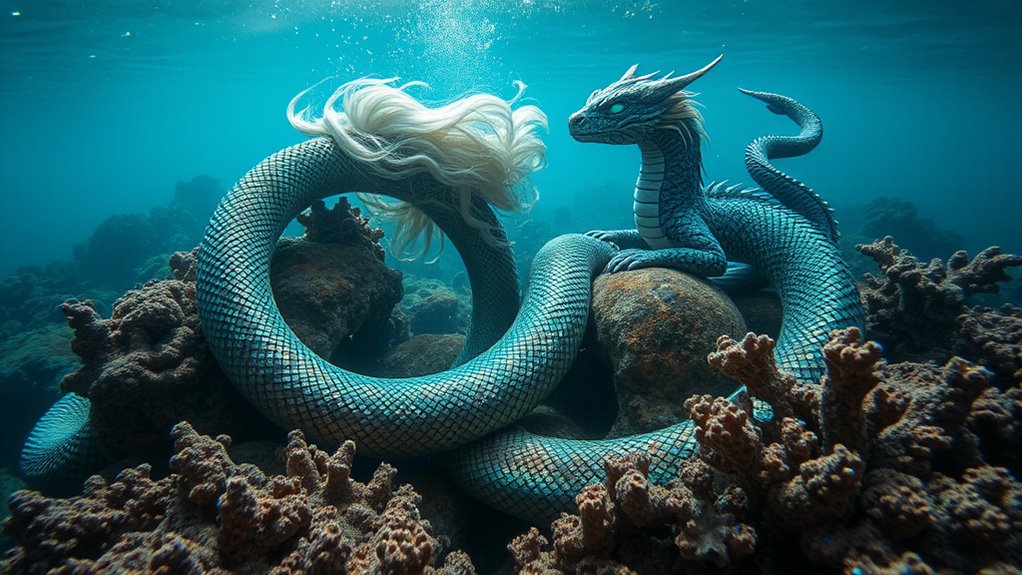
Sardinia’s coastal waters are rich with legendary sea guardians and spirits that have captivated local imagination for centuries. You might imagine Torco, son of Neptune, patrolling on a boat of reeds, warning of dangers with storms stirred by his mermen companions. These spirits are believed to defend Sardinia from invaders like Atlante, pirate marauders who repeatedly clashed with Torco. The Gulf of Angels, named in honor of celestial protectors, symbolizes divine guardianship over the sea. Meanwhile, Sella del Diavolo bears the mark of Lucifer’s defeat, a reminder of celestial battles near Cagliari. These myths evoke a powerful sense of protection and mystery, woven into Sardinia’s marine landscape. The stories often serve to foster cultural identity and preserve the island’s rich maritime heritage.
Sardinia’s Mythical Connection to Atlantis

Some experts believe Sardinia might be the real Atlantis Plato described, challenging traditional ideas placing the legendary island near Gibraltar. Italian scholar Sergio Frau suggests Sardinia’s unique features align with Plato’s account, including its location in the central Mediterranean beyond the “Pillars of Hercules.” The southern tip resembles an underwater Pompeii, with artifacts like metal tools and ceramics hinting at a sudden catastrophe. Sardinia’s Nuraghi structures, massive megalithic towers built between the 16th and 12th centuries BC, point to a sophisticated, advanced civilization that mysteriously declined around 1175 BC—coinciding with Atlantis’s timeline. The island’s archaeological and geographical clues support the idea that Sardinia could be the sunken continent of myth, hiding remnants of an ancient, lost civilization. Recent underwater explorations have uncovered additional artifacts and structures that further support the hypothesis of a submerged, once-thriving society being linked to the Atlantis legend. These discoveries underscore the importance of archaeological research in uncovering the truth about ancient civilizations.
Frequently Asked Questions
Are There Any Modern Sightings of Sardinian Mythical Creatures?
You wonder if anyone has seen Sardinian mythical creatures recently. While stories persist locally, there’s no solid evidence or verified reports of sightings today. Most accounts are anecdotal and lack physical proof, often rooted in folklore or misidentifications of natural phenomena. Scientific studies and environmental data show no signs these creatures are still around. So, unless new evidence surfaces, it’s safe to say modern sightings remain unconfirmed and likely part of tradition rather than reality.
How Do Sardinian Legends Influence Local Cultural Festivals?
You see that legends deeply shape Sardinian festivals by inspiring costumes, rituals, and storytelling. You’re part of events where masks and symbols reflect ancient myths, reinforcing community bonds. These stories add layers of meaning, connecting people to their history and land. As you participate, you help preserve traditions that celebrate natural cycles, collective identity, and ancestral beliefs, ensuring these cultural practices thrive amid modern changes.
What Are the Most Famous Caves Linked to Janas Legends?
Did you know there are over 3,500 Domus de Janas caves across Sardinia? You’ll find some of the most famous in Santu Perdu, Anghelu Ruju, Su Crucifissu Mannu, S. Andrea Priu, and S’incantu. These sites are renowned for their intricate tombs, vivid wall paintings, and symbolic carvings, believed to be linked to Janas legends. Exploring them offers a glimpse into ancient beliefs of protection, rebirth, and divine femininity.
Are There Archaeological Sites Associated With These Mythical Beings?
You’ll find several archaeological sites connected to these mythical beings. For example, the Domus de Janas are ancient rock-cut tombs that legends say are inhabited by Janas, tiny fairy-like creatures. These sites blend history and myth, giving you a glimpse into Sardinia’s rich folklore. Additionally, legends surround nuraghe structures and giant’s tombs, which are thought to be linked to mythic creatures like ogres and giants, adding a mystical layer to Sardinian archaeology.
How Do Sardinian Myths Compare to Other Mediterranean Folklore?
You see, comparing Sardinian myths to other Mediterranean folklore reveals shared themes of nature spirits, supernatural beings, and ancient rituals. Yet, Sardinia’s stories stand out with unique local elements like the Mamuthones and Janas, rooted in prehistoric sites. You’ll notice how myths incorporate archaeological landmarks and prehistoric traditions, creating a rich, distinctive tapestry that reflects the island’s ancient history, blending cultural influences with deeply embedded local identity.
Conclusion
As you imagine Sardinia’s mystical landscapes, feel the whisper of Janas dancing through the olive groves and the watchful eyes of legendary beasts guarding secret treasures. Picture the shimmering waves where mythical sea creatures stir beneath the surface, their stories echoing in the salty breeze. With every step, Sardinia’s legends invite you into a world where myth and reality entwine, guiding you through a land steeped in enchantment and ancient wonder, waiting quietly for your discovery.
